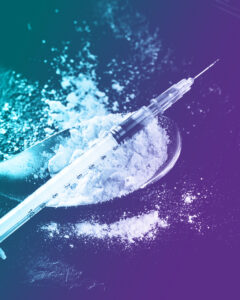How is Cocaine Used
You never really felt the need to stay up-to-date on trends surrounding substance use. Your son was a good kid, and he rarely got in trouble. Working as a single mom, you did your best to provide him with everything he needed to be successful in school.

Since he went off to college, he has been acting differently. You can see he is losing weight and he seems stressed out all the time. He brings up money a lot, saying it is hard to afford food and necessities even though he is working. You are concerned, but when you ask him where his money is going, he immediately changes the subject. Still, you know college can be stressful, and you send him money when he asks.
During this last visit, you notice some of your needles and syringes for your diabetes are missing. There is a strange, white residue on the bathroom counter, and it smells like something was recently burned. You look up what this could possibly be, and paired with your son’s behavior, you discover cocaine use disorder. How could this be? You didn’t even know you could inject cocaine, let alone that your son would find his way into using it.
In 2021, 143 deaths were caused by cocaine in Hillsborough County. Clean Recovery Centers has been working to educate our Suncoast communities on topics surrounding substance use disorders. Our program includes family in the treatment process, with weekly sessions once your loved one completes detox. Many are unfamiliar with the ways cocaine is ingested. Today’s blog will explore how cocaine is used and how to recognize if a loved one has been using it.
Common Methods of Using Cocaine
Cocaine is a stimulant derived from the coca plant native to South America. Commonly seen as a white powder or small, crystal-like rock, it was originally used to provide relief from indigestion and as a local anesthetic. However, as it became widely available, government officials began to notice the negative side effects it was having on the general public. It has remained an illicit substance since, including the coca plant itself.
There are different methods in which cocaine is used, but they all lead to the same effects. Common side effects of cocaine use include:
- Sensitivity to light and sound
- Bursts of productivity
- Mood swings
- Paranoia
- Distrust of others
- Extreme energy levels
- Insomnia
- Decreased appetite
Let’s explore the ways cocaine is used and how it affects the body.
Snorting Cocaine
Snorting cocaine is one of the most common ways of use. The powder is often arranged in lines or put on a small, spoon-like piece of metal and then inhaled through the nose. It then is absorbed through the mucous lining within the nasal cavity and enters the bloodstream. The effects can be felt within minutes and last around 30 minutes, depending on the person. Snorting is a preferred method because you don’t need specific paraphernalia. Cocaine can be snorted with straws or makeshift straws such as a rolled dollar bill.
Smoking Cocaine
When referring to smoking cocaine, the substance is actually crack. Crack-cocaine or just crack for short comes from cocaine powder that has been heated with an additive to form a rock. Common additives are baking soda or ammonia. The rock is then put in a glass pipe and heated with a lighter, creating smoke for inhalation. Smoking crack produces the same effects as cocaine powder. The effects are felt almost immediately and only last around 10 minutes. This is why smoking crack-cocaine is often seen in a binge pattern as the person tries to keep feeling the effects.
Injecting Cocaine
While injecting cocaine is not seen very often, it is still a possible way to use the substance. The powdered cocaine is added to water, creating a liquid. The liquid is then drawn into a syringe and injected into a vein. Because the cocaine is put directly into the bloodstream, the effects are immediate. However, this also means the effects are short-lived, lasting only around 5-10 minutes. It is not a convenient method to inject cocaine as it requires needles, syringes, something to tie the arm, and water.
Ingesting Cocaine
Ingesting cocaine can include swallowing the powder or dissolving it on the gums or under the tongue. When cocaine is ingested, the effects can be delayed, resulting in them being felt after 15 or so minutes. If the person has eaten, this could extend the process. Once the effects begin, they typically last close to an hour. Because of the delayed effects, ingesting cocaine is not a popular method of use.
Cocaine Use and Life-Altering Consequences
 There are many health risks involved with cocaine use, and they can vary based on the method of intake. Snorting cocaine results in damage to the nasal cavity. This can cause perforations in the septum, nasal collapse, and chronic nose bleeds. Cocaine causes tissue death, and once the nasal cavity tissues have died, there is no way to replace them. The damage will require surgery to repair.
There are many health risks involved with cocaine use, and they can vary based on the method of intake. Snorting cocaine results in damage to the nasal cavity. This can cause perforations in the septum, nasal collapse, and chronic nose bleeds. Cocaine causes tissue death, and once the nasal cavity tissues have died, there is no way to replace them. The damage will require surgery to repair.
Smoking crack-cocaine has risks similar to smoking tobacco. Chronic lung infections such as chronic obstructive pulmonary disease (COPD) are common in those who smoke crack. Paired with a weakened immune system from malnourishment, the length of time it takes to heal will be extensive.
Injecting cocaine has a slew of health risks. Using a needle to puncture the skin leaves a wound, and when the same area is used often, the wounds can become infected. This can lead to abscesses and infections. As we mentioned above, a weakened immune system will cause healing times to be longer than that of a healthy person. Also, sharing needles raises the risks of contracting HIV/AIDS and hepatitis.
Swallowing cocaine can wreak havoc on the digestive system. Cocaine causes blood vessels to constrict, leading to decreased blood flow to vital organs and tissues. Bowel death is common in cocaine use as blood doesn’t reach the areas that need it. When sections of the gastrointestinal tract die, they release waste into the body. This is a medical emergency as this waste is toxic and can damage other organs. Consequences of bowel death can result in the person needing a colostomy bag or having chronic issues with digestion.
All cocaine use comes with the risk of an overdose. When too much cocaine is in the body, it cannot keep up with trying to process it. This results in experiencing an overdose. Because cocaine is a stimulant, it speeds up body functions. Heart rate becomes erratic as body temperature rises. Heart attacks, strokes, and seizures are common conditions caused by a cocaine overdose. There is no medication to counteract the effects of cocaine. Seek medical attention immediately if you suspect someone is experiencing an overdose.
Getting Help for Cocaine Use Disorder in Hillsborough County, FL
Cocaine may seem to make you feel good, but the longer it is used the more damage it can cause. Physical ailments, lost relationships, and financial strain are common as cocaine takes over your life. The good news is that there is hope and help is available to get your life back. Cocaine addiction treatment is the first step in the right direction. With the help of licensed therapists and medical professionals, you will be able to focus on your health and leave cocaine behind. It may seem impossible now, but with coping skill development and addressing the root causes of your addiction, you can break free and end the cycle of cocaine use.
Managing a cocaine use disorder can take you away from the life you were meant to live. Clean Recovery Centers understands that there is more to addiction than just simply “using cocaine.” Our program addresses every facet of addiction: physical, mental, spiritual, and social. We even offer wellness components that are unique, including brain mapping, nutritional counseling, and many more. Call us today at (888) 330-2532 to schedule an appointment.
Get clean. Live clean. Stay clean.


